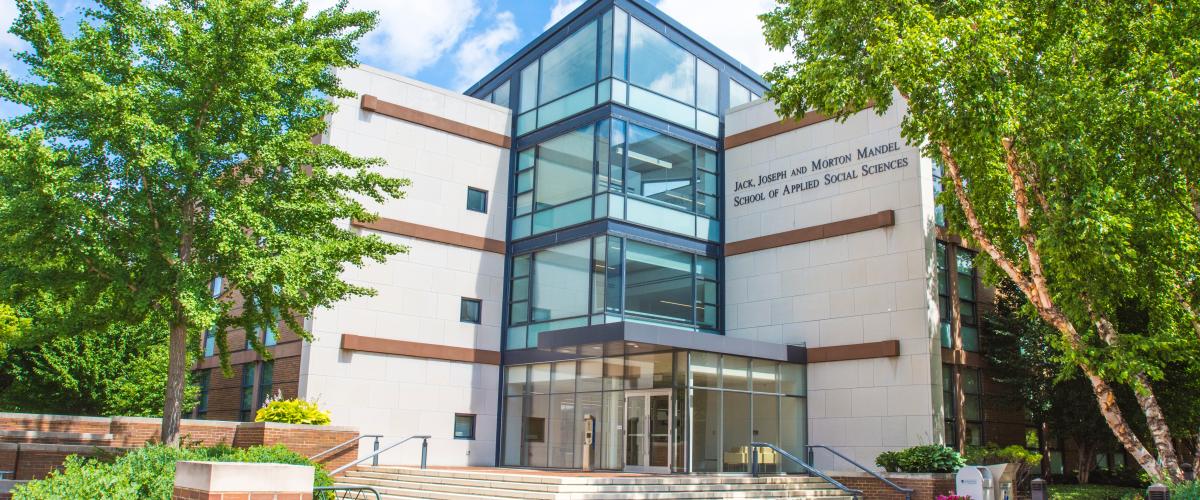University-wide course pairs social work and health sciences students for service-learning projects with local nonprofits
Each week, more than 500 health sciences and social work students at Case Western Reserve University gather to learn how to work together—all while benefiting the community.
They are future nurses, doctors, dentists, social workers, genetic counselors, psychologists and other health professionals who will influence their respective fields for decades.
“When students from different professions collaborate, they gain a deeper appreciation of the different values, mindsets, and cultures of each other’s professions—and the people they will be serving,” said Tyler Reimschisel, MD, founding associate provost of interprofessional and interdisciplinary education and research.
Since 2020, first-year health sciences and social work graduate students, as well as fourth-year undergraduate nursing students, have enrolled in Collaborative Practice I (CPI), an immersive mandatory yearlong program. Together, they practice approaches to interprofessional teamwork in the classroom—and through substantive service-learning projects with community organizations.
“Students get into the community, many times working with people who may have different backgrounds than them, to complete an authentic project together,” said Reimschisel, who is also co-director of CPI and professor of genetic and genome sciences at the School of Medicine. “Sometimes it’s much more challenging than they realize at first. That’s part of the process, too.”
For students from the Jack, Joseph and Morton Mandel School of Applied Social Sciences, the course’s emphasis on interprofessional collaboration and service are familiar concepts at the core of their future profession.
“Social work is inherently very interdisciplinary so we’re always working with different systems with folks from different professions,” said Scott Wilkes, PhD, JD (LAW ’94; GRS ’13, social welfare), assistant dean of academic affairs at the Mandel School, who teaches a CPI module on ethics. “The course is a natural fit for our students, but also a growth and leadership opportunity for them.”
Community connections
Students work in teams with a diverse range of community partners—such as food banks, after-school programs, social service providers and others—on projects addressing an equally broad range of issues and needs, including mental health, nutrition, and access to housing, healthcare and transportation. Each student team devotes around 25 hours to a project.
“Our profession is not exclusively health-focused like the others in the course, so social work students bring a unique perspective and value orientation to the projects,” said Amy Korsch-Williams (SAS ‘04), a senior instructor at the Mandel School who teaches a CPI module on cultural humility.
“Mandel School students understand how people interact with the larger social environment,” said Korsch-Williams. “It’s not just what’s happening in an exam room—it’s what’s happening with a person’s family and their community and support systems. That approach can be influential to students from other disciplines.”
Each team, composed of five to seven students from a mix of fields, is assigned a “champion” from a community organization who acts as a liaison and guide throughout their project.
“The experience has made me feel more hopeful about the future of medical practice,” said Carmine Stewart, vice president of programming for Seeds of Literacy, which provides free, personalized education to adult students.
As a multi-year CPI champion, Stewart has worked with student teams to produce health literacy lessons—designed to cater to a range of literacy levels—on topics Seeds students deem crucial, including heart attacks, domestic violence and breast cancer, as well as questions to ask during medical appointments.
“CPI students grasped that literacy is health literacy,” said Stewart. “If an adult is struggling with literacy, then they are at a disadvantage in learning and advocating for their health.”
This academic year, the student team held a focus group with Seeds students to hear firsthand about their challenges with the medical community—and what changes could help make those experiences more productive.
“The CPI team was fired up to make change,” said Stewart. “It clicked—they understood that if you’re an adult with a low level of literacy, it’s often because you were once a child someone didn’t advocate for—and that it’s not too late for someone to step up.”
Team-working
In classroom sessions, CPI students focus on how to work effectively as teams, with modules on emotional intelligence, psychological safety, collaborative decision-making, conflict management and more.
“There are times in healthcare when things are high stress, and communicating with others requires a lot of thought,” said Grace DiPierro, a first-year Master of Social Work (MSW) student. “As groups, we talk a lot about establishing psychological safety—feeling like you can be open and share with others—which will help us advocate for clients and patients during our careers.”
Since CPI launched three years ago, more than 220 community projects have been initiated or completed, involving nearly 1,500 students. This abundance of projects presented student teams several opportunities to practice conflict management and other techniques.
“We always say ‘the locus of control is within the team,’” said Reimschisel. “If students are having a challenge, welcome to reality. That’s how life works. Faculty will not fix problems teams are having, but we’ll coach them on how to approach the challenge.”
He added, “Students are typically very willing to talk about and work through issues openly, which shows they value the approach.”
Carlie Shelton, a first-year MSW candidate focused on gerontology, is part of a team working with Senior Transportation Connection, which offers cost-effective transport to seniors and individuals with disabilities.
While working on their project, which uses data and visual techniques to demonstrate transportation needs in the region, teammates have deliberately drawn on the interprofessional teamwork strategies taught in CPI.
“The class gives us space to try out new ways to work together and have constructive conversations. It’s a low-risk environment that helps us solve problems,” said Shelton. “It’s up to us to make this work.”
In the classroom, students also examine their own implicit biases and often discuss the history of Cleveland, focusing on how past policies and practices created health disparities, especially in communities of color.
This material has helped student teams forge constructive relationships with dozens of community organizations and champions, said Vanessa Jackson, a wellness coordinator at the May Dugan Center, an independent nonprofit that provides food and clothing distribution, educational resources, and behavioral health assistance, among other services, in Cuyahoga County.
Jackson, who has served as a champion since 2020 and is also a consultant to the CPI program, has seen firsthand how students can grow in their awareness of underserved communities and unmet needs. It’s given her reason to hope for a long-term shift in how health professions are practiced.
“As a woman of color, when I go into medical settings, sometimes I’m not treated well,” she said. “I feel like the next generation of medical professionals will have more insight into patients and clients. That’s very important.”
At the end of each academic year, during an energy-filled afternoon across a dozen classrooms at the university, teams present the results of their work at the CPI Showcase—displaying deliverables and discussing the challenges and lessons learned along the way.
Attending the showcase was an emotionally powerful experience for Carmine Stewart of Seeds of Literacy.
“It’s easy to see how students have developed a heart for folks who struggle,” she said, “and will carry that empathy forward.”
Calculating collaboration
Collaborative Practice I, since 2020:
1,499 students
245 student teams
222 community projects
132 local organizations
275 champions
By Daniel Robison
Read more stories like this in the Spring 2023 edition of Action.





